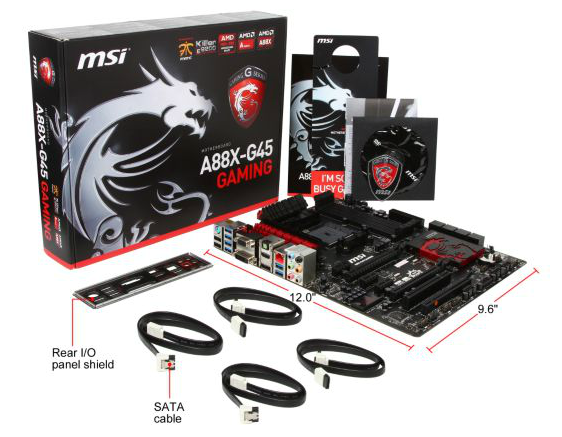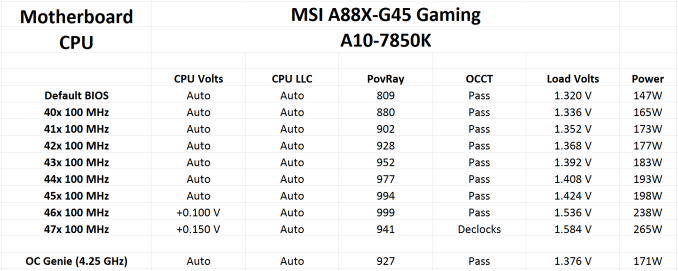MSI A88X-G45 Gaming Review
by Ian Cutress on August 11, 2014 8:00 AM ESTMSI A88X-G45 Gaming In The Box
Intel platforms offset the increased cost of the motherboard (mostly due to the chipset) with the potential to bundle in a series of extras. When you combine an AMD platform motherboard, which is aimed at a more cost-conscious market, with a gaming platform where users expect something a little bit different to help the experience, it puts companies like MSI in a tough place.
Inside the MSI A88X-G45 Gaming we get:
Driver DVD
Manuals
Rear Panel Shield
Four SATA Cables
Door Hanger: “I’m sorry, busy gaming”
MSI Gaming Case Badge
When using eight SATA 6 Gbps ports, four SATA cables was almost a given, but similarly to MSI’s other gaming motherboards, they include the door hanger and case badge here as well. While together both of these items are of little actual value or use to the system, if a user is building a system for a teenage family member, these little additional items might help enhance the experience.
MSI A88X-G45 Gaming Overclocking
Experience with MSI A88X-G45 Gaming
With previous overclocking tests, our A10-7850K has almost been the butt of a joke. Perhaps it was down to our sample, which seemed to struggle beyond 4.4 GHz. The A88X-G45 Gaming surprised me a little in this respect by offering an OC Genie speed of 4.25 GHz with only a touch of a button. This small boost should please almost all A10-7850K owners.
Delving into the manual overclocks, and the limit ends up being the CPU cooling competing against the CPU voltage. The higher the voltage, the higher the peak temperature and the more likely the system was to throttle. We saw this in other A88X motherboards, but for our tests the MSI A88X-G45 Gaming hit 4.6 GHz before it did throttle. Up until 4.5 GHz the auto voltage settings kept everything together, which is a pretty good response from a motherboard. It might also be worth noting that the peak power draw from stock to 4.6 GHz increased by almost 100W.
Methodology
Our standard overclocking methodology is as follows. We select the automatic overclock options and test for stability with PovRay and OCCT to simulate high-end workloads. These stability tests aim to catch any immediate causes for memory or CPU errors.
For manual overclocks, based on the information gathered from previous testing, starts off at a nominal voltage and CPU multiplier, and the multiplier is increased until the stability tests are failed. The CPU voltage is increased gradually until the stability tests are passed, and the process repeated until the motherboard reduces the multiplier automatically (due to safety protocol) or the CPU temperature reaches a stupidly high level (100ºC+). Our test bed is not in a case, which should push overclocks higher with fresher (cooler) air.
Overclock Results












12 Comments
View All Comments
purplestater - Monday, August 11, 2014 - link
This really makes me want to build another computer that I don't need and can't afford.PHlipMoD3 - Monday, August 11, 2014 - link
So, the A10 7850K beats an i7 4960X in 2 gaming benchmarks, and not a word is said about that in the article apart from "The MSI motehrboard takes the lead in CoH2 comfortably."Seems fishy to me, same card, more CPU bottleneck on the A10, and yet it beats a 4960X in gaming? Shenanigans.
tim851 - Monday, August 11, 2014 - link
The games in which the A10 comes out on top are not CPU bottlenecked, but clearly limited by GPU performance. A victory there is likely a statistical fluke.PHlipMoD3 - Monday, August 11, 2014 - link
I still find it quite a weird victory, even taking into account the GPU-limited state of BF4. CoH is also a CPU heavy title, and AMD seems to do well in it more often. I would like to have seen a comparison between the 9590 and the A10 in this case, instead of the more limited benches and comparisons in this article / review.I know its a motherboard review specifically, but more comparison points can't hurt.
Ian Cutress - Monday, August 11, 2014 - link
I just removed my CoH2 results: with it being on steam and requiring an online connection to initialise first on a new system, it of course downloads updates. It would seem CoH2 had a large update that I didn't see download which has affected the frame rates quite considerably: up to 15% with an A10. I am seeing this with the motherboards I have on the test bed, and is essentially nullifying all my previous results compared to the latest.DrMrLordX - Tuesday, August 12, 2014 - link
Is the latest CoH2 update showing any speed improvements on the 4960x or other Intel processors? I understand if the new software version skews current results to the point that they are no longer comparable to older benchmark runs, but at the same time, this sort of stinks for the 7850k. AMD won a benchmark? Pull it, it has to be a fluke!If the 4960x gained nothing from the update, then, guess what: the 7850k is actually the faster chip for CoH2.
Anonymous Blowhard - Monday, August 11, 2014 - link
> why would a user purchase such an APU and then disable access by adding a discrete GPU?Because they're a complete pillock.
Now, if someone were to purchase a cheap-as-chips FM2 Athlon X4 750K, OC the living daylights out of it, and pair that with a dGPU ... well, then they'd be a savvy budget gamer, now wouldn't they?
iTzSnypah - Monday, August 11, 2014 - link
Well if AMD releases a Kaveri based Athlon X4 then maybe. Currently a G3458+H81 board is cheaper and blows a 750K/760K out of the water gaming, especially once you overclock the Pentium.StrangerGuy - Thursday, August 14, 2014 - link
Exactly, who in the right mind would buy this $120 mobo given the Pentium AE and a H81 board is the same price? By the time you put a FM2 CPU/APU into that thing you could have well easily got a discrete card for budget gaming purposes. Of course they will be AMD tryhards deriding the AE being "loldualcore" while conveniently ignoring being massively GPU limited with AMD CPU is a universally FAR worse experience.Phartindust - Thursday, August 14, 2014 - link
Wrong question. The right question is why would anybody purchase an APU and NOT crossfire it with an appropriate AMD GPU? Putting a Nvidia gpu with an AMD APU makes no sense at all